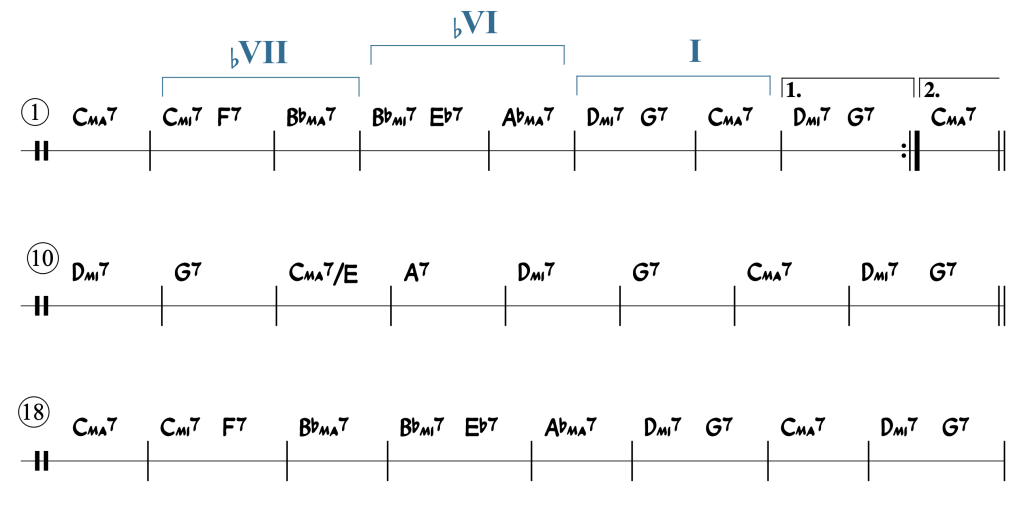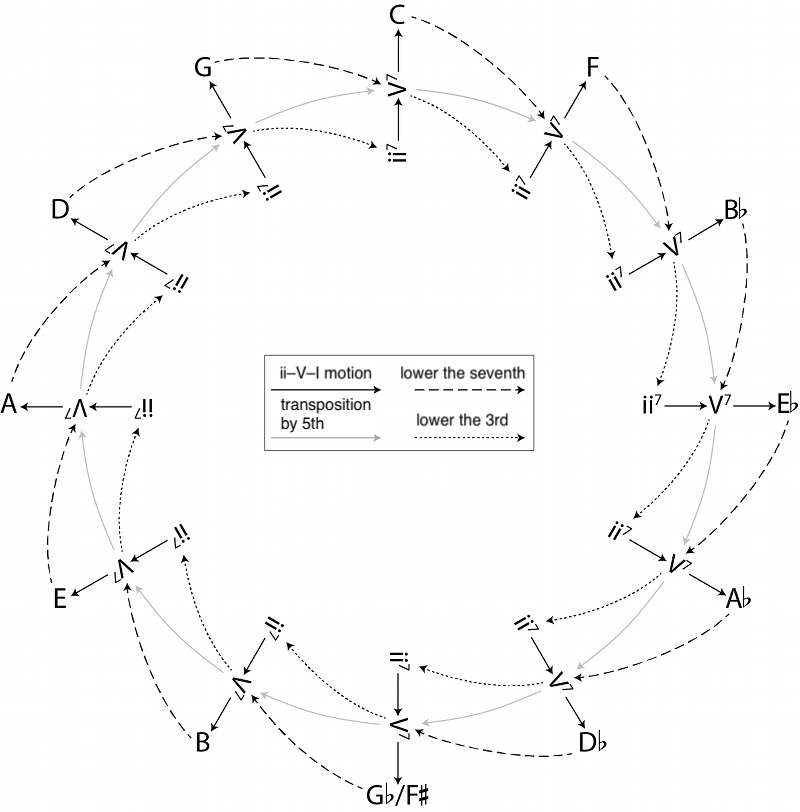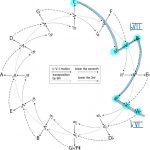VI. Jazz
ii–V–I
Megan Lavengood
Key Takeaways
- ii7–V7–Ima7 in major, or ii∅7–V7–i7 in minor, is a fundamentally important progression in traditional jazz.
- The ii–V–I progression can be identified through a combination of root motion by fifths plus its distinctive sequence of chord qualities (mi7–7–ma7 in major, or ∅7–7–mi7 in minor).
- Because this progression is so important to jazz, the concept of applied chords can expand to include applied subdominant chords—i.e., the ii chord.
- Incomplete ii–V–Is, i.e., ii–Vs, can also be identified because the combination of root motion and quality is so distinctive.
Example 1 shows final cadences from four jazz tunes. Look at the harmonies—a pattern should be apparent. (You can listen to the tunes through the the Spotify playlist for this chapter.)
Example 1. “Afternoon in Paris,” “All the Things You Are,” “My Funny Valentine,” and “Joy Spring” all share similar harmonic progressions at their final cadences: ii–V–I.
All the examples end in perfect authentic cadences (PACs). But the similarities don’t end there: each PAC is preceded by the ii chord. So we have three chords, each related to the next by fifth.
This ii–V–I progression is one of the most important progressions in jazz music. You can find it reliably at cadences, but also as a building block that occurs throughout a tune. When the progression occurs in a major key, as in the snippets in Example 1, the chord qualities of these chords are mi7–7–ma7. When the tune is in minor, the shift in mode changes the quality of the harmonies to ∅7–7–mi7 (the V chord is major whether you are in a major or minor key). Both of these progressions and a typical voice-leading pattern are summarized in Example 2.
Example 2. Prototypical harmonies and voice leadings in ii–V–I progressions, in both major and minor modes.
ii–V–I as Schema
Schema is a useful concept in music theory, used in many ways within this book (pop harmony, for one). Put simply, schemas are common patterns our brains can recognize, even when variations are altering a specific presentation of that schema.
The ii–V–I progression is an example of a schema. It happens so frequently that informed listeners can recognize the schema in many formats. Some examples of alterations are given in Example 3. In “Misty,” the ma7 chord is replaced with a 6 chord (this occurred in “My Funny Valentine” in Example 2 also). In “Prelude to a Kiss,” the typically dominant-quality V chord is replaced with an augmented chord (the minor seventh is preserved). The V chord is altered in “A Night in Tunisia,” but this time, the fifth is lowered instead of raised.
Example 3. The ii–V–I is still recognizable, even if alterations occur.
Applied ii–Vs
An important marker of dominant-function chords is the chord’s quality. This is most obvious in the case of the dominant seventh quality, since it has “dominant” in the name. Fully diminished chords also have dominant function.
The compositional technique of applied chords capitalizes on the relationship between quality and function by taking dominant chords out of their key and dropping them into a new key. The applied dominant chords retain their function as dominant chords even when applied to a chord other than I (this concept is fully explained in the Tonicization chapter).
The omnipresence of ii–V–I as a schema in jazz means that in this style, we can have not only applied dominants, but applied ii chords as well. In other words, the entire ii–V–I progression can be used in keys other than the tonic key to tonicize another chord. The association between these chord qualities and root motions is so strong that a ii–V progression need not even resolve to its I chord to create the effect of a ii–V.
Take the rest of the A section of “Afternoon in Paris” as an example (Example 4). Not only does it end with a ii–V–I progression, but it begins with two other ii–V–Is: one tonicizing B♭ major, which is ♭VII in the key of C, immediately followed by another in A♭ major, which is ♭VI in the key of C.

ii–V space
By relating all possible ii–V–I motions together, we can come up with a space in which these progressions operate, and visualize how the ii–V–Is in “Afternoon in Paris” are related. This idea comes from Michael McClimon (2017), and his “ii–V space” is reproduced in Example 5. The space is arranged as the circle of fifths (note the letter names at the end of each progression), with each chord in the circle preceded by a ii–V.

There are four different variations of arrows in Example 5, and each signifies a different transformation from the first chord to the chord at the other end of the arrow. The two solid arrows have to do with root motion: the black arrows connect chords within a ii–V–I schema, while the gray arrows show the circle-of-fifths relationships. The dashed arrows show changes to chord quality. The larger dashes indicate that the chord is the same except that the seventh has been lowered, so each larger-dashed arrow connects a ma7 chord to a (dom)7 chord with the same root. The smaller dashes show that the chord is the same, but the third has been lowered: each smaller-dashed arrow connects a 7 chord to a mi7 chord with the same root.

Example 6 traces the progressions in “Afternoon in Paris” that were annotated in Example 4. Notice how the space helps to illustrate the logic of the progression: by transforming the preceding Ima7 chords into ii7 chords, it forces a modulation down by whole step.
Understanding a piece through the ii–V schema
The logic of a chromatic progression like the one in Lee Morgan’s “Ceora” becomes more intelligible when viewed through this lens. An analysis originally by McClimon is explained in the video below (Example 7).
Example 7. “Ceora” by Lee Morgan is entirely composed of ii–V–Is.
Turnarounds
A particularly common version of applied ii–Vs comes in what is called the turnaround. In the broadest sense, a turnaround is a progression that serves to loop back to the original tonic chord, and the typical progression that achieves this is I–vi–ii–V–I. Using the concept of applied chords, we can substitute a V7/ii for the vi chord, since they share the same root. But we can also precede that V7 with its ii chord—effectively, a ii/ii (two of two). Thus, the ii chord of the turnaround is tonicized with its own ii–V–(I) progression. This tonicized version of the turnaround is a very common variant (Example 8).
Example 8. The turnaround schema has diatonic and chromatic variants.
- Aebersold, Jamey. 1974. The II–V7–I Progression. Vol. 3. Jamey Aebersold Play-A-Long Series. New Albany, IN: Jamey Aebersold Jazz.
- McClimon, Michael. 2017. “Transformations in Tonal Jazz: ii–V Space.” Music Theory Online 23 (1). http://mtosmt.org/issues/mto.17.23.1/mto.17.23.1.mcclimon.html.
- ii–V–I worksheet (.pdf, .docx). Worksheet playlist Note that these lead sheets are not public domain and thus cannot be posted here; however, the lead sheets are not difficult to find if you search the internet or ask around.
- Composing with ii–V–I worksheet (.pdf, .mscz). This functions as a preparatory assignment for the Bebop Composition.
Media Attributions
- afternoon in paris © Megan Lavengood is licensed under a CC BY-SA (Attribution ShareAlike) license
- McClimon’s ii–V space © Michael McClimon adapted by Megan Lavengood is licensed under a CC BY-SA (Attribution ShareAlike) license
- ii–V space with “Afternoon in Paris” © Megan Lavengood is licensed under a CC BY-SA (Attribution ShareAlike) license
ii⁷–V⁷–Imaj⁷ in major, or iiø⁷–V⁷–i⁷ in minor. A fundamentally important progression in traditional jazz.
The distance between roots of adjacent chords. For example, "root motion by step" refers to the distance between two chords that are only one step apart, such as I and ii, IV and V, etc. Note that the root is not always in the bass, so this is a separate concept from bass motion.
A term that summarizes the quality of the third, fifth, and seventh (if applicable) above the root of the chord. Common chord qualities are major, minor, diminished, half-diminished, dominant, and augmented.
A seventh chord in which the triad quality is minor and the seventh quality is also minor. For example: C–E♭–G–B♭.
A seventh chord in which the triad quality is major and the seventh quality is minor.
A seventh chord with a major triad and a major seventh.
A seventh chord in which the triad quality is diminished and the seventh quality is minor.
A prototypical chord progression or formal structure.
A category of chords that provides a sense of urgency to resolve toward the tonic chord, including V and vii° (in minor: V and vii°).
A chromatic chord that temporarily tonicizes another key besides the tonic key, by taking on a dominant function in that new key.
The process by which a non-tonic triad is made to sound like a temporary tonic. It involves the use of secondary dominant or leading-tone chords.
The use of a non-tonic chord (usually dominant) at the end of a harmonically closed unit to transition into the beginning of the following on-tonic unit. In jazz, the term "turnaround" often refers to the progression vi–ii–V–I. The exact qualities of these chords are highly variable, and one or more of the chords may be substituted with a different, related chord.

